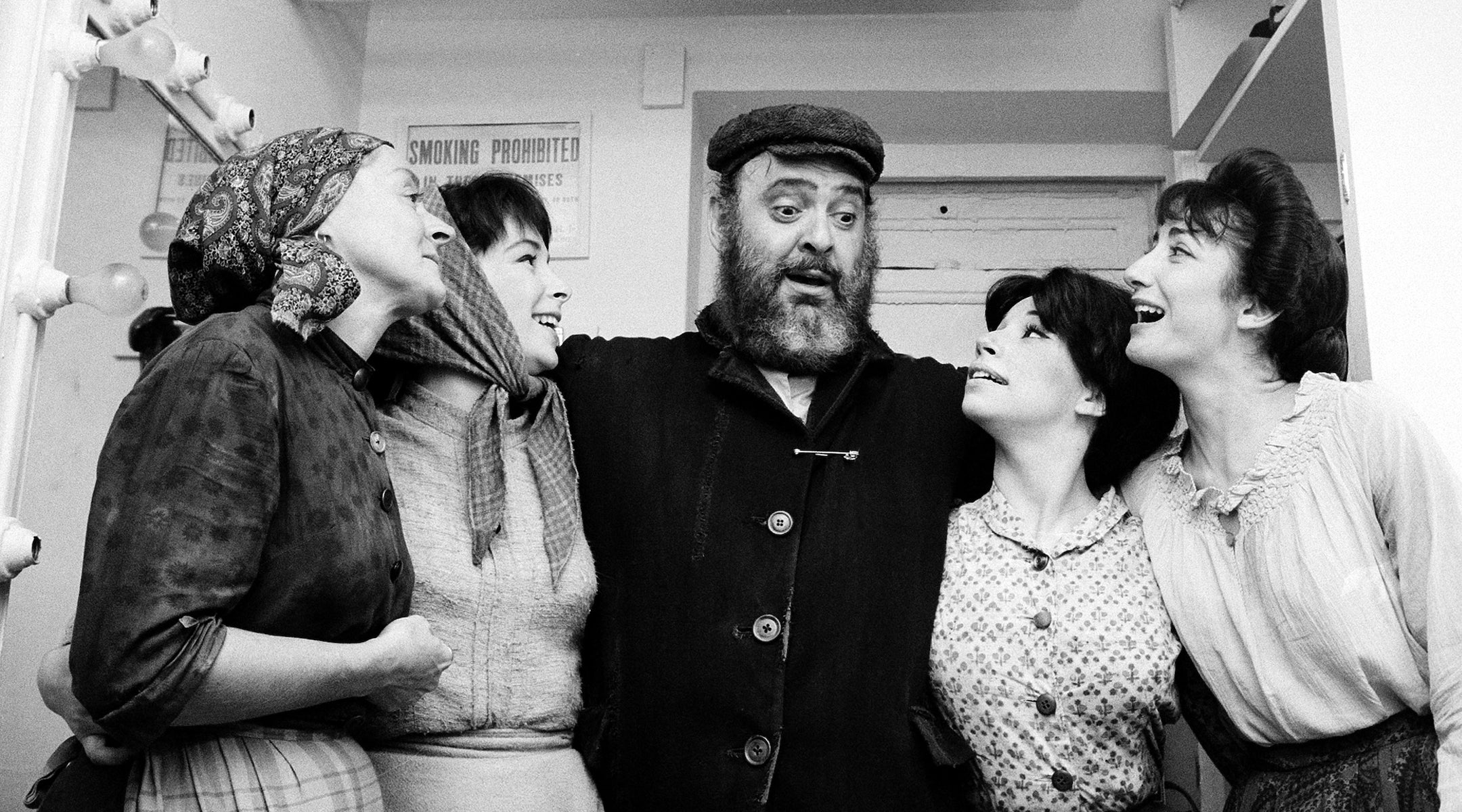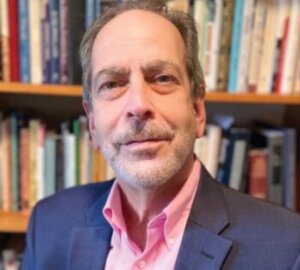How the late actor Topol turned Tevye into a Zionist
The star of ‘Fiddler on the Roof’ brought his Israeli self to a musical film about the Jewish Diaspora.

Topol appears as Tevye in the 1971 film “Fiddler on the Roof.” Photo by Silver Screen Collection/Getty Images
(JTA) — If you were born anytime before, say, 1975, you might remember Israel not as a source of angst and tension among American Jews but as a cause for celebration. In the 1960s and ’70s, most Jews embraced as gospel the heroic version of Israel’s founding depicted in Leon Uris’ 1958 novel “Exodus” and the 1960 movie version. The 1961 Broadway musical “Milk and Honey,” about American tourists set loose in Israel, ran for over 500 performances. And that was before Israel’s lightning victory in the Six-Day War turned even fence-sitting suburban Jews into passionate Zionists.
That was the mood when the film version of “Fiddler on the Roof” came out in 1971. The musical had already been a smash hit on Broadway, riding a wave of nostalgia by Jewish audiences and an embrace of ethnic particularism by the mainstream. The part of Tevye, the put-upon patriarch of a Jewish family in a “small village in Russia,” was originated on Broadway by Zero Mostel, a Brooklyn-born actor who grew up in a Yiddish-speaking home. Ashkenazi American Jews tended to think of “Fiddler” as family history — what Alisa Solomon, author of the 2013 book “Wonder of Wonders: A Cultural History of Fiddler on the Roof,” describes as the “Jewish American origin story.”
But Mostel didn’t star in the film, which landed in theaters while the afterglow of Israel’s victory in its second major war of survival had yet to fade. Famously – or notoriously – the part went to Chaim Topol, a young Israeli actor unknown outside of Israel except for his turns in the London productions of “Fiddler.” With an Israeli in the lead, a musical about the perils and dilemmas of Diaspora became a film about Zionism. When Topol played Tevye in London, Solomon writes,“‘Fiddler’ became a site for celebration, drawing Jews as well as gentiles to the theater — some for repeat viewings — to bask in Jewish perseverance and to pay homage to Jewish survival. The show didn’t change, but the atmosphere around it did.”
Topol died this week at 87, still best known as Tevye, and his death reminded me of the ways “Fiddler” is — and isn’t — Zionist. When Tevye and his fellow villagers are forced out of Anatevke by the czarist police, they head for New York, Chicago and Krakow. Only Yente, the matchmaker, declares that she is going to the “Holy Land.” Perchik, the presumably socialist revolutionary who marries one of Tevye’s daughters, wants to transform Russian society and doesn’t say a word about the political Zionists who sought to create a workers’ utopia in Palestine.
“There is nothing explicitly or even to my mind implicitly Zionist about it,” Solomon told me a few years back. And yet, she said, “any story of Jewish persecution becomes from a Zionist perspective a Zionist story.”
When the Israeli Mission to the United Nations hosted a performance of the Broadway revival of “Fiddler” in 2016, that was certainly the perspective of then-Ambassador Dani Danon. Watching the musical, he said, he couldn’t help thinking, “What if they had a place to go [and the Jews of Anatevke could] live as a free people in their own land? The whole play could have been quite different.”
Israelis always had a complicated relationship with “Fiddler,” Solomon told me. The first Hebrew production was brought to Israel in 1965 by impresario Giora Godik. American Jews were enthralled by its resurrection of Yiddishkeit, the Ashkenazi folk culture that their parents and grandparents had left behind and the Holocaust had all but erased. Israelis were less inclined to celebrate the “Old Country.”
“Israelis were — what? — not exactly ashamed or hostile, but the Zionist enterprise was about moving away from that to become ‘muscle Jews,’ and even denouncing the stereotype of the pasty, weakling Eastern European Jews,” said Solomon, warning that she was generalizing.
That notion of the “muscle Jew” is echoed in a review of Topol’s performance by New Yorker critic Pauline Kael, who wrote that he is “a rough presence, masculine, with burly, raw strength, but also sensual and warm. He’s a poor man but he’s not a little man, he’s a big man brought low — a man of Old Testament size brought down by the circumstances of oppression.”

Mostel, by contrast, was plump, sweaty and vaudevillian — a very different kind of masculinity. The congrast between the two Tevyes shows up in, of all places, a parody of “Fiddler” in Mad magazine. In that 1976 comic, Mostel’s Tevye is reimagined as a neurotic, nouveau riche suburban American Jew with a comb-over, spoiled hippy children and a “spendthrift” wife; Topol’s Tevye arrives in a dream to blame his descendants for turning their backs on tradition and turning America into a shallow, consumerist wasteland. A kibbutznik couldn’t have said (or sung) it better.
Composer Jerry Bock, lyricist Sheldon Harnick and book writer Joseph Stein set out to write a hit musical, not a political statement. But others have always shaped “Fiddler” to their needs.
In the original script, Yente tells Tevye’s wife Golde, “I’m going to the Holy Land to help our people increase and multiply. It’s my mission.” In a 2004 Broadway revival, staged in the middle of the second intifada, the “increase and multiply” line was excised. In a review of Solomon’s “Wonder of Wonders,” Edward Shapiro conjectured that the producers of the revival didn’t want Yente to be seen as “a soldier in the demographic war between Jews and Arabs.”
Topol himself connected “Fiddler” to Israel as part of one long thread that led from Masada — the Judean fortress where rebellious Jewish forces fell to the Romans in the first century CE — through Russia and eventually to Tel Aviv. “My grandfather was a sort of Tevye, and my father was a son of Tevye,” Topol told The New York Times in 1971. “My grandfather was a Russian Jew and my father was born in Russia, south of Kiev. So I knew of the big disappointment with the [Russian] Revolution, and the Dreyfus trial in France, and the man with the little mustache on his upper lip, the creation of the state of Israel and ‘Masada will never fall again.’ It’s the grandchildren now who say that. It’s all one line — it comes from Masada 2,000 years ago, and this Tevye of mine already carries in him the chromosomes of those grandchildren.”
The recent all-Yiddish version of “Fiddler on the Roof” — a Yiddish translation of an English-language musical based on English translations of Yiddish short stories — readjusted that valence, returning “Fiddler” solidly to the Old Country. It arrived at a time when surveys suggested that Jews 50 and older are much more emotionally attached to Israel than are younger Jews. For decades, “Exodus”-style devotion to Israel and its close corollary — Holocaust remembrance — were the essence of American Jewish identity. Among younger generations with no first-hand memories of its founding or victory in the 1967 war, that automatic connection faded.
Meanwhile, as Israeli politics have shifted well to the right, engaged liberal Jews have rediscovered the allure of pre-Holocaust, pre-1948, decidedly leftist Eastern European Jewish culture. A left-wing magazine like Jewish Currents looks to the socialist politics and anti-Zionism of the Jewish Labor Bund; symposiums on Yiddish-speaking anarchists and Yiddish-language classes draw surprisingly young audiences. A Yiddish “Fiddler” fits this nostalgia for the shtetl (as does the “Fiddler” homage in the brand-new “History of the World, Part II,” which celebrates the real-life radical Fanny Kaplan, a Ukrainian Jew who tried to assassinate Lenin).
Topol’s Tevye was an Israeli Tevye: young, manly, with a Hebrew accent. Mostel’s Tevye was an American Tevye: heimish, New York-y, steeped in Yiddishkeit. It’s a testament to the show’s enduring appeal — and the multitudes contained within Jewish identity — that both performances are beloved.
This article originally appeared on JTA.org.

















